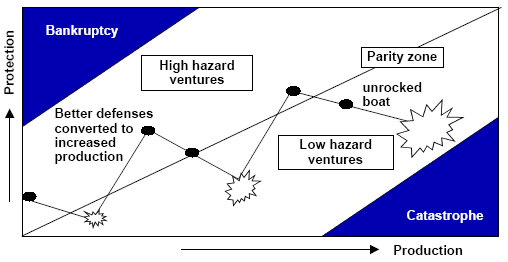
Dr. James Reason developed
this chart to describe the relationship between protection
and production over the history of a hypothetical organization. Those
in high-hazard ventures — such
as wildland firefighting
— should operate above the parity zone, that is, protection should
at least “match the hazards of productive operations.”

The 10th Fire Order
reflects our need to balance production and protection: “Fight fire
aggressively, having provided for safety first.” Like others in
high hazard ventures, firefighters have traded improvements in protection
for productive advantage.
The availability of fire shelters has led some to fight fire in the absence
of escape routes and safety zones.

Organizations develop
layers of defense between the hazards and people/assets at risk from
operations. However the layers are rarely perfect, with
holes like a slice of Swiss cheese.

When the “holes” of
every “slice” line
up, the system provides a trajectory for an accident to occur.